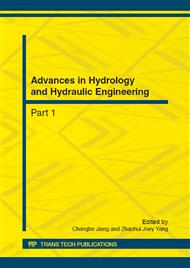p.441
p.446
p.453
p.457
p.461
p.466
p.477
p.482
p.489
Experimental Study on Formation Cause of Sink Reach’s River Pattern of Alluvial River Flowing into the Lake
Abstract:
The formation cause of sink reach’s river pattern of the alluvial river flowing into the lake was studied by the experiment method. The results showed that: the change of lake level was the important formation condition of the alluvial river’s sink reach. The sediment concentration, the riverbed gradient were the major factors influencing the river pattern’s evolution of the sink reach. When the sediment concentration of upstream river was less, the sink reach was inclined to form a straight river, and with the increase of the sediment concentration, the bifurcated river was the chief river pattern. When the sediment concentration increased to a certain value, the sink reach was inclined to form a wandering river. When the riverbed gradient was less, the sink reach was inclined to form a bifurcated river, and with the increased of the gradient, the wandering river was the main river pattern. The sediment diameter affected channel evolution, but the influence extent was less.
Info:
Periodical:
Pages:
461-465
Citation:
Online since:
October 2012
Authors:
Price:
Сopyright:
© 2012 Trans Tech Publications Ltd. All Rights Reserved
Share:
Citation:


